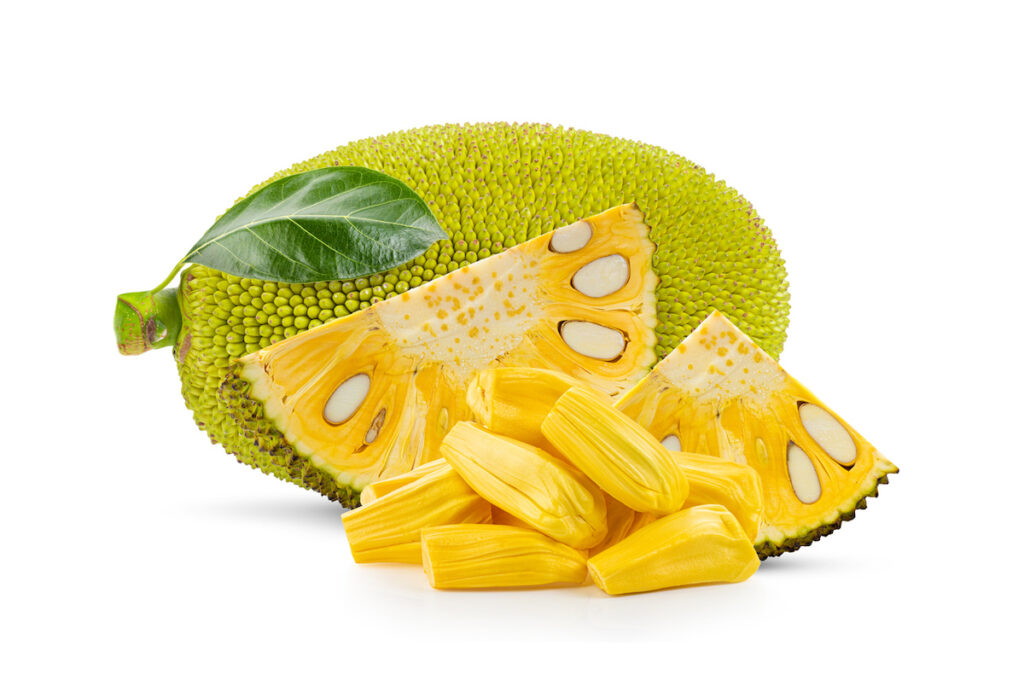Update January 2023: we have some Jackfruit seedlings available, please contact us for more details.
Jackfruit, the colossal gem of the tropical fruit world, has been creating a buzz in the culinary scene not just for its savoury, meaty texture when unripe but also for its sweet, aromatic flavours at maturity. It’s no wonder that New Zealanders, with their adventurous palates and love for gardening, are showing an increasing interest in cultivating this exotic fruit on their own soil. While it may seem like a daunting endeavour, growing jackfruit in NZ is not just a dream for devoted gardeners. This article will guide you through the journey of the jackfruit, from its native tropical forests to your very own Kiwi garden. Discover how to cultivate, care for, and ultimately harvest your own jackfruit wonders under the long white cloud.

The Jackfruit Journey
Jackfruit, scientifically known as Artocarpus heterophyllus, is native to the Western Ghats of India but has made its way across Asia and the tropical regions of the world. It’s the largest tree-borne fruit, with a single jackfruit capable of reaching up to 55 kilograms in weight. This fruit’s journey to New Zealand is a testament to its adaptability and the curiosity of gardeners looking to push the boundaries of what can be grown in their local environments. As more people embrace plant-based diets, the jackfruit’s popularity soars, thanks to its versatile use in culinary applications.
The journey of the jackfruit to New Zealand is not merely a physical one; it is a cultural sojourn too. As diverse communities have settled in New Zealand, they have brought with them a taste for the tropical fruit, integrating it into the local food tapestry. In acknowledging the jackfruit’s potential, enterprising Kiwis have started to explore ways to cultivate it in their own backyards.
Adapting to New Zealand’s climate is a challenge, but it is one that the jackfruit is well equipped for. With a bit of knowledge and dedication, NZ gardeners can mimic the fruit’s natural environment, encouraging it to flourish. The journey from seed or sapling to a fruit-bearing tree is a rewarding process, one that offers a tangible connection to the natural world and the satisfaction of homegrown success.
For the jackfruit to make itself at home in New Zealand, it demands patience and perseverance from the gardener. As with any botanical venture, success is often found in trial and error, but this adds to the allure of growing such an exotic fruit. The story of jackfruit in NZ is still being written, and those who join in its cultivation are pioneers on the frontiers of gardening.
Cultivating in Kiwi Climes
The first step to growing jackfruit in New Zealand is understanding the country’s varied climate zones. While the North Island offers a more subtropical environment, which is more conducive to growing jackfruit, the cooler South Island poses a greater challenge and would require utilizing a greenhouse.
The Western Bay of Plenty, Coromandel, Auckland and Northland are the best areas for jackfruit in NZ. It’s a tropical tree whose range extends down into the subtropics. Some varieties might offer more cold resistance, such as J33, but we don’t have enough data on this yet. Experimentation is key!
The key to success is mimicking the jackfruit’s natural tropical habitat, which means ensuring adequate warmth and protection from frost, which can be devastating to a young jackfruit tree. In the warmer northern regions, jackfruit trees can often be grown outdoors with minimal protection. However, in cooler areas, gardeners must be prepared to offer additional warmth through the use of frost cloth, mulch, or even temporary structures to shield young trees during the coldest months. In our tests, young Jackfruit trees would drop their leaves over winter, while those with some form of protection (wind cloth, plastic above) would keep their leaves.
The soil in New Zealand varies greatly from region to region, but jackfruit trees prefer well-drained, fertile soil that is rich in organic matter. To get the best out of your jackfruit tree, consider enriching your soil with compost and well-rotted manure before planting. In areas with heavy soil, creating raised beds or planting on a slope can help prevent waterlogging, which can lead to root rot.
Water is another critical factor in cultivating jackfruit in NZ. While the trees are drought-tolerant once established, they need regular watering during their formative years, especially in the drier regions of the country. A deep watering system that reaches the roots is preferable, encouraging strong root development. Overhead watering should be avoided to prevent fungal diseases that thrive in the moist canopy conditions.
Choosing the Perfect Spot
For your jackfruit tree to thrive, choosing the right location in your garden is paramount. The ideal spot would be a sheltered area that receives ample sunlight throughout the day—jackfruit loves the heat and light. South-facing slopes or walls that retain heat can provide an extra boost of warmth, which is particularly beneficial for this tropical plant.
Wind protection is another important aspect to consider. Jackfruit trees have large leaves that can be easily damaged by strong winds. Planting your tree near a natural windbreak like a fence, hedge, or alongside other trees can help to minimize wind stress. Additionally, being mindful of how the wind moves through your property will allow you to position your jackfruit in a spot where it’s buffered yet still receives good air circulation to deter pests and diseases.
Drainage is a critical consideration when selecting a site for your jackfruit tree. The spot should drain well to prevent water from pooling around the roots, which can be deadly for the tree. If drainage is a concern, consider building up the soil into a mound or planting into a raised bed to ensure excess water can easily drain away.
Proximity to your home or outdoor living areas can also be a factor, as fully grown jackfruit trees not only provide bountiful fruit but can also offer pleasant shade and visual interest. However, it’s important to plant the tree at a suitable distance from structures and pipes, as its extensive root system can potentially cause damage if too close.
Planting the Tropical Giant
Once you have selected the perfect spot, the next step is planting your jackfruit tree. If you’re planting a young tree, it’s essential to handle it with care to avoid damaging the roots. A hole twice as wide as the root ball and just as deep is ideal, allowing room for the roots to expand. Incorporating compost and a balanced fertilizer into the soil at this stage can give your sapling a nutrient boost for better establishment.
It’s important to plant at the right time of year. In New Zealand, the best time to plant jackfruit is in the spring, after the risk of frost has passed. This allows the tree to acclimate and establish its roots before the colder months. Planting in the spring also takes advantage of the growing season, giving the tree a full season to grow before it faces its first winter.
Watering the newly planted jackfruit tree is vital to help settle the soil around the roots and eliminate any air pockets. Be generous with water in the early days, but avoid waterlogging the soil. A good practice is to create a watering well around the base of the tree to direct water straight to the roots and make watering more efficient.
Mulching around the base of the tree can help retain soil moisture, suppress weeds, and provide a slow release of nutrients as the mulch breaks down. Be sure to leave some space around the trunk to prevent rot and to allow for proper air circulation. Organic mulches such as straw, bark, or wood chips are excellent choices for a jackfruit tree. This is especially important if your land has the dreaded kikuyu.
Caring for Your Jackfruit Tree
Regular care is essential for a thriving jackfruit tree. Fertilizing with a balanced, slow-release fertilizer throughout the growing season will support robust growth and fruit production. It’s also important to monitor the tree for signs of nutrient deficiencies, which can manifest in the leaves’ colour and condition, and to adjust your feeding regimen accordingly.
Watering remains important throughout the life of your jackfruit tree, especially during dry spells. Deep watering that reaches the roots is more beneficial than frequent, shallow waterings. As the tree matures, it will become more drought-tolerant, but keeping a regular watering schedule will ensure your tree remains healthy and productive throughout the year.
Harvesting Your Hefty Fruits
The excitement of growing your own jackfruit culminates in the harvest. Knowing when to harvest can be tricky, as jackfruits do not ripen all at once. Look for changes in the fruit’s colour and a characteristic sweet smell emanating from the fruit as indicators that it’s ready to be picked. The fruits also develop a dull, hollow sound when tapped, signalling maturity.
Handling jackfruit requires some preparation due to its sticky sap. Coating your hands and tools with vegetable oil before harvesting can make the process less messy. Cutting the fruit away from the tree with a sharp knife or pruning saw, while supporting the weight of the fruit, can prevent damage to both the tree and the fruit.

Leave a Reply